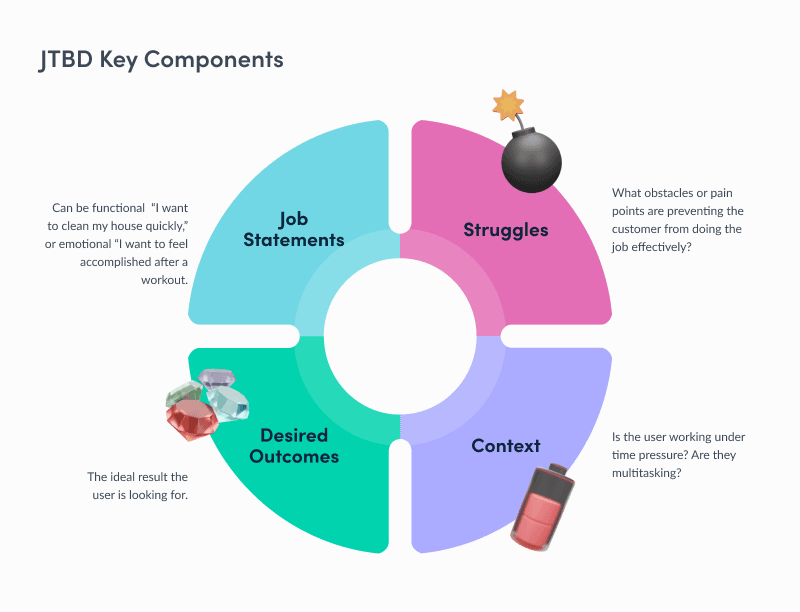Updated: August 5, 2025- 22 min read
At its core, product innovation is about finding new ways to solve problems or meet customer needs. Sometimes, it’s a bold leap, but often, it’s a series of smaller steps that add up to something valuable.
Whether it’s rethinking an overlooked feature or introducing a fresh take on a familiar product, innovation doesn’t have to be flashy to be effective — it just has to work.
Take any successful company, and you’ll find product innovation woven into its strategy. It’s how businesses adapt to changing markets, stay competitive, and discover opportunities for growth.
In this article, we’ll break down what product innovation really means, why it’s essential, and how you can turn ideas into results.
Opportunity Solution Tree Template
Branch out and discover something new with the opportunity solution tree. Visualize the product discovery process to build features that matter!
Get the template
What Is Product Innovation?
At its simplest, product innovation is the process of creating new products or significantly improving existing ones to solve problems, meet customer needs, or open new markets. It’s not just about making something new — it’s about delivering meaningful value in ways that redefine what’s possible for consumers or businesses.
Product innovation plays a crucial role throughout the product lifecycle, but it’s during the Discovery stage that the most groundbreaking innovations often take shape. This is when teams venture into uncharted territory. They explore ideas and assumptions to uncover unmet needs and opportunities. While inherently risky, this phase allows for the bold thinking and experimentation that drive meaningful breakthroughs.
Take Post-it Notes as an example. In the 1970s, Spencer Silver, a hall-of-fame scientist at 3M, was trying to develop a strong adhesive but instead created a glue that stuck lightly and could be removed without damage. Initially deemed a failure, the team reimagined its purpose, leading to the creation of one of the most iconic office supplies of all time. This success was born out of curiosity, persistence, and a willingness to pivot—hallmarks of product innovation.
This process isn’t limited to revolutionary products; it also includes smarter ways of doing things, such as refining a design or enhancing usability. Product innovation is a blend of creativity, resourcefulness, strategy, and execution. It’s about challenging the status quo, embracing unexpected solutions, and turning small breakthroughs into tangible results.
Whether you’re working on incremental improvements or entirely new concepts, product innovation helps businesses adapt to change, stay relevant, and even shape the future. It’s a powerful driver of growth, especially when combined with a structured approach like product discovery to validate ideas and mitigate risks early in the lifecycle.
By understanding where product innovation fits within the product lifecycle and recognizing its potential in the Discovery stage, teams can harness this process to deliver exceptional value and set the foundation for long-term success.
Why is new product innovation important for companies?

Consumer expectations evolve, technology advances, and competitors emerge. Without innovation, even the most successful products risk becoming obsolete. Here are the key reasons why product innovation is crucial for companies:
Staying Competitive: Product innovation helps companies maintain a competitive edge by offering unique solutions that differentiate them from rivals.
Meeting Evolving Customer Needs: As consumer expectations change, innovation ensures products stay relevant and aligned with market demands.
Driving Growth: New or improved products open up additional revenue streams, expand market share, and create opportunities in untapped markets.
Enhancing Brand Perception: Innovative products position a company as a forward-thinking leader, boosting brand credibility and customer loyalty.
Improving Operational Efficiency: Innovations often streamline production, reduce costs, or improve product quality, contributing to long-term profitability.
Fostering Resilience: Companies that innovate are better equipped to adapt to disruptions, such as market shifts or emerging competitors.
Creating Market Trends: Instead of following trends, innovative companies set them, influencing customer behavior and leading industry transformations.
Attracting Talent and Partnerships: A reputation for innovation makes companies more attractive to top talent, investors, and potential collaborators.
Securing Long-Term Survival: In industries prone to rapid change, continuous innovation is vital to remain relevant and avoid obsolescence.
How companies overcome common product innovation challenges
We really want to make sure that when we do any new products, we are building trust with our clients and do that over the long term. This means carefully balancing innovation with risk management.
— David Myszewski, VP of Product at Wealthfront, on The Product Podcast
The high risk of failure
Address the high risk of failure by conducting thorough market research and piloting ideas with Minimum Viable Products (MVPs). Gather feedback early to refine your product and align it with customer needs, increasing its chances of success.High costs
Manage high costs by forming partnerships, applying for grants, or using lean innovation strategies. Collaborate with other organizations or secure funding to innovate without overextending your resources.Long development timelines
Mitigate long development timelines by adopting Agile methodologies. Break projects into smaller, manageable iterations, and gather feedback at every stage to adapt quickly and keep your development aligned with market needs.Uncertainty in market acceptance
Engage customers in co-creation to tackle uncertainty in market acceptance. Involve them in your product design process to ensure the final offering resonates with their needs, minimizing resistance.Internal resistance to change
Foster a culture of innovation by championing initiatives, encouraging experimentation, and supporting your team in taking calculated risks. Use digital transformation frameworks to overcome resistance and drive progress.Balancing incremental and radical innovation
Balance incremental and radical innovation by managing your product portfolio strategically. Allocate resources to both short-term improvements and long-term disruptive projects to ensure steady growth while exploring new opportunities.Resource allocation challenges
Prioritize high-impact initiatives using frameworks like the Eisenhower Matrix or cost-benefit analysis. Focus your efforts on projects that deliver the most value to make the best use of your resources.Regulatory and compliance issues
Involve your legal and regulatory teams early in the development process to address compliance requirements proactively. This approach saves you time and avoids costly delays.Maintaining a culture of innovation
Create cross-functional teams and reward creativity to maintain a culture of innovation. Encourage collaboration across departments to spark fresh ideas and sustain momentum by recognizing and celebrating achievements.Disruptive market conditions
Build flexibility into your innovation strategy to handle disruptive market conditions. Be ready to pivot quickly in response to external changes while staying focused on your long-term goals.
These solutions not only help companies overcome challenges but also turn them into opportunities for growth and differentiation.
Lack of innovation? What causes stagnant teams

Juan Manuel Agudo Carrizo
Head of Product. Formerly at Real Madrid & eBay.
“The first driver of innovation is psychological safety. If you don’t create an environment based on empathy, where people can raise their voices, build rapport, and feel safe making mistakes, then they’ll be afraid and won’t innovate. So the first step is creating a space where people can speak up, challenge each other, and feel not stressed but excited and engaged about what they’re doing.
The second one is empowering teams. If you don’t give teams the ability to choose their own KPIs — KPIs that actually influence your North Star metrics — then they’re going to stay reactive. They’ll become feature factories. You need to give them the bandwidth to choose meaningful KPIs, align on goals, and then commit to those metrics. Without that space, there’s no real innovation. Teams will just learn how to game the system to deliver on time. That’s not the environment you want. In the end, innovation is about empowerment and making teams outcome-driven.”
When teams feel stagnant, it's rarely because they’ve run out of ideas — more often, they’ve run out of space to speak freely or own meaningful goals. As Juan Agudo explains, innovation isn’t a lightning bolt — it’s the result of a deliberately designed environment.
Innovation starts with psychological safety. Teams need to feel safe raising concerns, taking risks, and making mistakes without fear of retribution. Without that baseline, even the most creative teams will stay quiet and play it safe.
The other key factor is empowerment. When teams are handed goals they didn’t help define, or when they’re measured by surface-level metrics, they default to checking boxes. Real innovation requires room to define success and accountability for driving it.
To create an innovation-friendly environment:
Encourage open dialogue and normalize failure as part of the process.
Let teams choose KPIs that tie into the company’s North Star but give them control over how to get there.
Avoid turning teams into feature factories — shift the focus from outputs to outcomes.
Align on goals, but let teams take ownership of the path forward.
If your team isn’t innovating, it may not be due to a lack of creativity — it may be a signal that they don’t feel safe or empowered to do their best thinking.
Product Innovation Process vs. Process Innovation
While product innovation focuses on creating or improving products to meet customer needs, process innovation revolves around enhancing how products are made or delivered.
Process innovation often improves efficiency, reduces costs, and boosts operational scalability.
For example, while a product innovation might result in a revolutionary smartphone design, a process innovation could streamline its production, making it faster and more cost-effective. Both are critical to business success, but they target different aspects of value creation.
Understanding the distinction helps highlight how various types of product innovation complement process improvements.
Types of product innovation
Incremental Innovation
Incremental innovation involves small but meaningful improvements to existing products. Think of adding new features, enhancing product design, or upgrading materials to improve performance. For example, smartphone manufacturers introduce better cameras or battery life year after year. While less dramatic than radical innovation, incremental changes help businesses maintain customer loyalty and adapt to evolving market needs.Radical (or Disruptive) Innovation
Radical innovation redefines industries by creating entirely new markets or reshaping existing ones. The introduction of the first iPhone is a prime example—it revolutionized communication and media consumption. Such innovation is risky, often requiring significant investment and vision, but it can yield transformative rewards for early adopters and market leaders.Sustaining Innovation
Sustaining innovation focuses on refining existing products to maintain or improve their product positioning. For example, high-performance car manufacturers, like Ferrari, consistently enhance their engines and design without disrupting the market. This type of innovation caters to current customers by delivering incremental value while ensuring brand relevance.Architectural Innovation
Architectural innovation takes existing technologies and rearranges them into new structures or configurations. The shift from traditional desktop PCs to laptops is a perfect illustration. By rethinking how components work together, companies can tap into entirely new customer segments or applications.Modular Innovation
Modular innovation involves significant changes to specific components within a product without altering its overall design. For instance, upgrading a smartphone’s processor or introducing a new camera module. It allows for significant performance improvements while retaining compatibility with existing systems, often at a lower cost.Open Innovation
Open innovation leverages external collaborations, partnerships, or technologies to drive new product ideas. Companies like Procter & Gamble use external networks to source ideas, reduce development time, and increase creativity. This approach helps businesses access a broader pool of expertise and accelerate innovation cycles.Service Innovation
Service innovation enhances the product experience by introducing new or improved services around a product. For example, Tesla’s over-the-air software updates keep vehicles updated without a visit to a service center. This type of innovation strengthens customer relationships by delivering ongoing value.
By understanding and leveraging these diverse types of product innovation, companies can strategically position themselves for sustained Product-led Growth (PLG) and adaptability in dynamic markets, as demonstrated by these examples of innovative companies that excel at PLG.
Steps to Building a Product Innovation Strategy
1. Define clear objectives for innovative product development
A successful product innovation strategy begins with defining clear and measurable objectives. Start by asking foundational questions:
What does the company want to achieve through innovation?
Are you aiming to penetrate new markets, improve customer satisfaction, increase market share, or introduce groundbreaking technology?
Align these objectives with overarching business goals and ensure they are supported with OKRs. Collaborate with cross-functional teams to gather diverse perspectives on what the company should prioritize, ensuring alignment and buy-in from the start.
2. Understand market needs
A deep understanding of your market is non-negotiable. Innovation without customer insights is like shooting arrows in the dark.
Conduct market research to uncover unmet needs, pain points, and emerging trends. Use customer surveys, focus groups, and interviews to gather qualitative data, and complement this with quantitative research such as analyzing customer behavior through CRM tools or web analytics.
Mapping the user flow helps identify gaps in current solutions and reveals opportunities for differentiation. Leveraging AI-driven tools for product teams can further uncover patterns in customer preferences or underserved niches.
3. Foster a culture of innovation
A successful innovation strategy is impossible without the right organizational mindset. Innovation thrives in a culture where risk-taking, collaboration, and creativity are actively encouraged.
Here are some ways to spark innovation in your company:
Empower Teams with Autonomy: Employees should feel empowered to take ownership of innovation projects, set their own milestones, and explore creative solutions without micromanagement. This fosters accountability, creativity, and passion for achieving innovative outcomes.
Build Diverse Teams: Cross-functional groups with varied expertise bring unique perspectives to the table. Product teams that include members from different departments, geographic locations, and backgrounds can uncover insights that homogenous groups may overlook. This diversity strengthens problem-solving and encourages robust ideation.
Encourage Open Feedback Loops: Regular retrospectives, innovation-specific review sessions, and open channels for feedback ensure ideas evolve iteratively. Weekly progress reviews can help teams refine concepts, address roadblocks, and implement incremental improvements.
Provide Resources for Experimentation: Establish tangible initiatives like dedicated innovation funds to support bold ideas. These funds allow teams to pilot new projects without fear of resource constraints or failure. Allocating a specific percentage of the operational budget for experimental initiatives shows a strong commitment to fostering innovation.
Celebrate and Reward Innovation: Recognize and reward employees who contribute to innovative efforts, even when ideas are not immediately implemented. Public acknowledgment, bonuses, or other incentives can motivate teams to continue pushing creative boundaries.
Organize Innovation Workshops or Hackathons: These events encourage cross-functional collaboration and serve as a catalyst for generating breakthrough ideas. They also allow teams to step away from daily tasks and focus entirely on innovation.
Establishing a tangible innovation fund can encourage employees to test and pilot ideas, reinforcing that innovation is a priority across the organization.
4. Prioritize opportunities in product development and innovation
Once you have a list of potential innovations, it’s essential to evaluate and prioritize them systematically. Randomly pursuing every idea is a recipe for wasted resources and missed opportunities. A structured approach ensures focus on high-value initiatives.

Here is how to prioritize effectively:
Validate Opportunities: Use an Opportunity Solutions Tree Template to plan and execute experiments and validate potential solutions with prototypes, a/b tests, etc.
Use a Scoring System: Rate each idea on key criteria such as market demand, technical feasibility, alignment with strategic goals, and potential ROI. For example, a product scorecard can be used to assign weighted scores to each factor, providing an objective way to compare initiatives.
Apply Prioritization Frameworks: Utilize tools like the MoSCoW method (Must-have, Should-have, Could-have, Won’t-have) or Agile Story Points to determine the importance and effort required for each project. These prioritization frameworks help balance quick wins with more resource-intensive innovations.
Map on an Innovation Matrix: Categorize ideas as incremental, adjacent, or transformational. This matrix helps balance short-term gains with long-term breakthroughs, ensuring a mix of safe bets and bold moves.
Focus on Customer Impact: Prioritize projects that directly address critical customer pain points or unmet needs. Use feedback from customer interviews, surveys, and user research to validate the importance of each idea.
5. Develop a roadmap
A product roadmap is the blueprint for executing your product innovation strategy. It provides structure and clarity, outlining timelines, resource needs, and key milestones. Choosing the right type of roadmap can greatly influence how well your team supports and executes innovative initiatives.
Here are the types of roadmaps you can create to support your Product Innovation efforts:
Outcome-Based Roadmap: Focuses on the results you aim to achieve rather than specific deliverables. This approach encourages flexibility and aligns innovation efforts with broader business goals. It’s particularly effective for fostering creative solutions without being overly prescriptive.
Timeline Roadmap: Presents a detailed schedule of when specific tasks, features, or milestones will be completed. While more rigid, this roadmap ensures accountability and provides clear deadlines, making it ideal for managing complex innovations with tight schedules.
Now-Next-Later Roadmap: Groups initiatives into three timeframes—immediate, near-term, and future priorities. This roadmap is highly adaptable, allowing teams to focus on present needs while maintaining a vision for long-term innovation.
Here are the components of a strong product roadmap:
Define critical phases: Ideation, prototyping, testing, development, and launch.
Assign accountability: Clearly identify owners for each task and deliverable.
Incorporate feedback loops: Build regular check-ins to refine the process based on progress and market feedback.
A well-constructed roadmap ensures that everyone — from leadership to project teams — stays aligned on goals and expectations, while the choice of roadmap type supports innovation by aligning with the specific needs and dynamics of the project.
6. Validate proposed solutions early
Assumptions are inevitable in the early stages of innovation, but they’re also dangerous if left unchecked. Validating these assumptions with experimentation quickly minimizes risk and avoids wasted resources.
Develop prototypes or Minimum Viable Products (MVPs) to test ideas in real-world conditions. Collect feedback directly from target customers to refine the product and ensure it addresses real needs effectively.
Testing assumptions early ensures you invest resources in ideas with proven potential.
7. Execute and monitor progress
Execution transforms product innovation strategy into reality, but effective monitoring ensures that the process stays on track and delivers results. This involves continuously evaluating progress, addressing obstacles, and adapting to changes.
Steps for execution and monitoring:
Define clear OKRs (Objectives and Key Results): Set ambitious objectives paired with measurable key results, such as increasing customer adoption by 20% or achieving a 95% satisfaction rate. OKRs encourage alignment and focus on outcomes rather than just activities.
Use product management tools: Platforms like ClickUp or Missive enable real-time tracking of tasks, dependencies, and resource allocation, ensuring transparency across teams.
Conduct regular reviews: Schedule weekly or bi-weekly check-ins to assess progress on OKRs, address challenges, and realign efforts if necessary. Use these reviews to celebrate milestones and recalibrate for greater impact.
Adaptability is key. If the data indicates a need to pivot, act quickly and decisively to realign efforts with market demands. Innovation is an iterative process, and flexibility ensures that initiatives remain relevant and impactful.
Types of Innovation: 17 Frameworks
1. Disruptive Innovation Model
Disruptive innovation explains how smaller companies can challenge established players by targeting overlooked market segments with simpler, more affordable solutions. Disruptive approaches are best used when entering mature markets dominated by incumbents, particularly in industries with underserved customer bases.
Teams in startups or companies exploring new market opportunities can leverage this model to disrupt the status quo.
2. Open Innovation Model
Open innovation involves using external ideas, collaborations, or partnerships to accelerate innovation. It’s ideal for organizations that want to expand their innovation capacity without relying solely on internal R&D.
As pointed out on Idea Scale’s blog, this model works well for companies with large networks of partners, vendors, or academic collaborations.
3. Innovation Funnel Model
The innovation funnel visualizes, as reported by The Big Bang Partnership, the process of narrowing down a wide range of ideas to focus on the most viable ones. It’s best used in organizations with large pipelines of ideas that need systematic evaluation and filtering.
Teams in R&D-heavy industries benefit from this structured approach to prioritizing projects.
4. Blue Ocean Strategy
This framework focuses on creating uncontested market spaces, or “blue oceans,” by delivering value innovation and differentiation. It’s ideal for teams aiming to avoid head-to-head competition in saturated markets.
The Blue Ocean Strategy is most effective in industries with potential for rethinking value propositions.
5. Lean Startup Methodology
The Lean Startup approach emphasizes rapid experimentation, building Minimum Viable Products (MVPs), and iterating based on feedback. It’s perfect for product teams in startups or new product divisions aiming to minimize waste and time to market.
This model thrives in environments with high uncertainty and evolving customer needs.
6. Stage-Gate Process
The Stage-Gate process divides the innovation journey into phases, with decision points (“gates”) between them to assess progress. It’s best used in large organizations managing complex projects that require formal oversight.
Teams operating in industries like pharmaceuticals or engineering benefit from its structured approach.
7. Design Thinking

Design Thinking is a human-centered framework focusing on empathy, ideation, and prototyping to solve user problems. It’s most effective for teams working on user-focused innovations or redesigns.
This model suits industries like tech, healthcare, and consumer goods, where user experience is critical. Read more on Product School’s blog.
8. Double Diamond Framework

The Double Diamond divides innovation into four stages: Discover, Define, Develop, and Deliver. It’s ideal for teams needing a clear, iterative process to refine ideas and solutions.
This framework is widely used in design-heavy industries and creative problem-solving contexts.
9. The Three Horizons Framework
The Three Horizons model, as reported by the Board of Innovation, categorizes innovation efforts into current operations (Horizon 1), emerging opportunities (Horizon 2), and future possibilities (Horizon 3). It’s best for organizations balancing immediate needs with long-term growth.
Strategic planning teams and innovation leaders find this model particularly useful.
10. Jobs-to-be-Done (JTBD) Framework

JTBD focuses on understanding the “job” a customer hires a product to do, helping uncover unmet needs. It’s perfect for teams aiming to deeply understand customer motivations and design user-centric products.
It’s widely applied in SaaS, consumer goods, and service industries.
11. Oslo Manual Framework
The Oslo Manual provides guidelines for measuring and analyzing innovation in terms of products, processes, marketing, and organizational changes. It’s most useful for teams in government or academic settings conducting innovation analysis.
This framework suits organizations needing standardized reporting and metrics.
12. TRIZ (Theory of Inventive Problem Solving)
TRIZ uses patterns of innovation identified in patents to solve technical problems systematically. It’s ideal for engineering or technical teams seeking structured, repeatable approaches to creative problem-solving.
This model thrives in industries like manufacturing and product design.
13. Doblin’s Ten Types of Innovation
This framework identifies ten dimensions of innovation, including business model, process, and product experience. It’s best for teams seeking a holistic view of innovation opportunities across their organization.
It’s widely used in industries aiming to integrate multiple innovation types.
14. Ambidextrous Organization Model
The Ambidextrous Organization balances optimizing current operations (exploitation) with pursuing new opportunities (exploration). It’s ideal for large enterprises navigating market disruption while maintaining core business stability.
Teams in tech and manufacturing often adopt this model.
15. Business Model Canvas
The Business Model Canvas template helps visualize key elements of a business model, such as customer segments and value propositions. It’s perfect for teams exploring new business ideas or iterating on existing models.
Startups and strategic planners benefit from its simplicity and clarity.
16. Stingray Model
The Stingray Model, explained in detail by the Board of Innovation, emphasizes a central core of strategic oversight with flexible, cross-functional teams that can pivot quickly. It’s best for organizations operating in highly dynamic and uncertain markets.
Agile teams and startups benefit from this model’s adaptability and focus on speed.
17. First Principles Thinking
First Principles Thinking, as seen on Forbes, involves breaking down complex problems into their most fundamental truths and building solutions from the ground up. It’s best used when tackling problems with no clear precedent or when existing solutions feel inadequate.
This approach suits teams working in highly innovative industries, such as tech or space exploration, where creativity and challenging assumptions are key.
5 Well-Known Examples of Product Innovation
From groundbreaking technologies to subtle yet impactful improvements, the best innovations address real-world problems and create lasting value. The following examples showcase how companies have successfully leveraged innovation to disrupt industries and meet the needs of their customers.
1. Apple iPhone
The iPhone is a textbook example of radical innovation. When it launched in 2007, it combined a phone, an iPod, and an internet browser into a single, sleek device.
This redefined how people communicate, consume media, and access the web. It spawned the smartphone industry as we know it. Apple's focus on usability, elegant design, and an ecosystem of apps set the gold standard for mobile devices.
2. Tesla’s electric vehicles
Tesla disrupted the automotive industry by making electric vehicles (EVs) not only viable but desirable.
Models like the Tesla Model S introduced innovations such as over-the-air software updates, autopilot capabilities, and an expansive supercharger network. By focusing on design, performance, and sustainability, Tesla turned EVs from niche products into mainstream aspirations.
3. Dyson vacuum cleaners
Dyson revolutionized the vacuum cleaner market by introducing bagless vacuum technology and powerful suction systems.
James Dyson’s focus on solving the inefficiencies of traditional vacuums led to the creation of cyclonic separation technology. This innovation not only improved performance but also eliminated the recurring cost of replacement bags, creating immense value for consumers.
4. Spotify’s music streaming service
Spotify reimagined how we consume music by providing instant access to millions of songs through a subscription model. Its innovation lies in leveraging algorithms for personalized playlists like “Discover Weekly” and pioneering music streaming as a service.
By solving the pain points of music piracy and limited access, the Spotify model transformed the music industry and set the stage for subscription-based content consumption.
5. Nike Flyknit Shoes
Nike Flyknit technology introduced a single-piece knitted upper that reduces waste, improves comfort, and enhances performance. The innovation was both functional and sustainable, as it cut down on material usage and production complexity. Flyknit exemplifies how innovation can meet customer needs while addressing environmental challenges.
Product Innovation Begins With a Mindset
Problems can be reframed, assumptions challenged, and solutions reimagined. Teams need to believe in this and cherish the innovation mindset.
But a mindset alone isn’t enough. Companies must nurture this outlook with the right support systems, structures, and processes to bring bold ideas to life.
Whether empowering teams through autonomy, adopting frameworks that streamline creativity, or fostering an environment of experimentation, the most innovative organizations combine vision with execution.
Product Leadership Certification
Elevate your product strategy and decision-making by integrating AI-driven insights.
Enroll now
Updated: August 5, 2025





